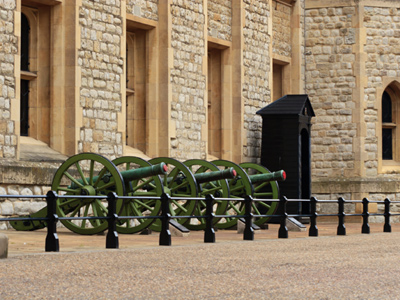
William I’s White Tower is situated in the Tower of London.
Saxon and Norman London
When the Romans retreated from London from 410 AD, the Saxons came to dominate the town. The Saxons were in turn replaced as rulers by William the Conqueror and his Norman successors following the famous Battle of Hastings in 1066. Test your knowledge on Saxon and Norman London.
1 .
Which Saxon king allegedly ‘burnt the cakes’?
Baldric the Baker
Cerdic of Wessex
Edward the Confessor
Alfred the Great
Alfred once hid from the raiding Vikings in a peasant woman’s cottage in Somerset. Unaware of her visitor’s regal status she chided him for having let the cakes that were cooking in her oven get burnt
2 .
Which of these was a name for London in the Saxon Era?
Vicus Lundoniae
Augusta
Lundenwic
Hamwic
The old English -wic, as in Ipswich, denotes a port or trading town. Southampton was previously called Hamwic and in the 300s London was named Augusta
3 .
Lundenwic was the name for the Saxon settlement situated near the area now known as The Strand. In the 800s when facing Viking attacks, the Saxons moved their settlement inside the old Roman city further east. What did they call this second settlement?
Lundenberg
Hamburg
Westerham
Charlottenburg
The remains of the Roman town were reoccupied in 886. A ‘burgh’ refers to a fortified town
4 .
Why was Edward the Confessor so named?
Because he made his people confess to crimes they hadn’t committed
Because he had committed petty theft in his youth and confessed
Because he was pious
Because he acknowledged his weakness as a monarch
He also took a vow of chastity which greatly contributed to his lack of heir and the subsequent Norman invasion
5 .
Which of these was NOT a London fortress built by the Normans?
Montfichet Tower
Baynard’s Castle
The White Tower
The Red Tower
Montfichet Tower and Baynard’s Castle have been lost over the centuries but William I’s White Tower still keeps a watchful eye over London from within The Tower of London
6 .
Which of these was not a Saxon village on the outskirts of London?
Soefhamton
Cloppenham
Cambeerwelle
Brixges Stane
The other three villages are now Clapham, Camberwell and Brixton
7 .
The heptarchy was a period in Saxon Britain (c.500-850) when the isles were split into 7 kingdoms, each with their own ruler. Which kingdom was London in?
Kent
Essex
Mercia
Northumbria
The other three kingdoms were East Anglia, Sussex and Wessex
8 .
Which Saxon king founded the first royal palace at Westminster, now more commonly known as The Houses of Parliament?
Alfred the Great
Edward the Elder
Edward the Confessor
Athelstan
Edward was building an impressive and ambitious new palace at Westminster and wanted to remain nearby to oversee the building progress
9 .
To what does ‘le-Bow’ refer to in the name of the church of St Mary-le-Bow?
The coffins
The archers’ bows that were stored there
The arches in its crypt
The Roman pavement within its basement
The church takes its name from the Norman arches in its crypt. You can admire them to this day whilst enjoying a hearty meal in the crypt cafeteria: Café BeLow
10 .
In 1011 Ranulph de Flambard, a Norman bishop of London, became the Tower of London’s first recorded prisoner and its first prisoner to escape too! How did he escape?
Via a window using a smuggled rope
Through a trap door and secret exit
By feigning sickness
By overpowering the guards
After his successful escape, he set sail for Normandy and a life of freedom
**Unlimited Quizzes Await You! 🚀**
Hey there, quiz champ! 🌟 You've already tackled today's free questions.
Ready for more?
Ready for more?
🔓 Unlock UNLIMITED Quizzes and challenge yourself every day. But that's
not all...
not all...
🔥 As a Subscriber you can join our thrilling "Daily Streak" against other
quizzers. Try to win a coveted spot on our Hall of Fame Page.
quizzers. Try to win a coveted spot on our Hall of Fame Page.
Don't miss out! Join us now and keep the fun rolling. 🎉
**Unlimited Quizzes Await You! 🚀**
Hey there, quiz champ! 🌟 You've already tackled today's free questions. Ready for more?
🔓 Unlock UNLIMITED Quizzes and challenge yourself every day. But that's not all...
🔥 As a Subscriber you can join our thrilling "Daily Streak" against other quizzers. Try to win a coveted spot on our Hall of Fame Page.
Don't miss out! Join us now and keep the fun rolling. 🎉







